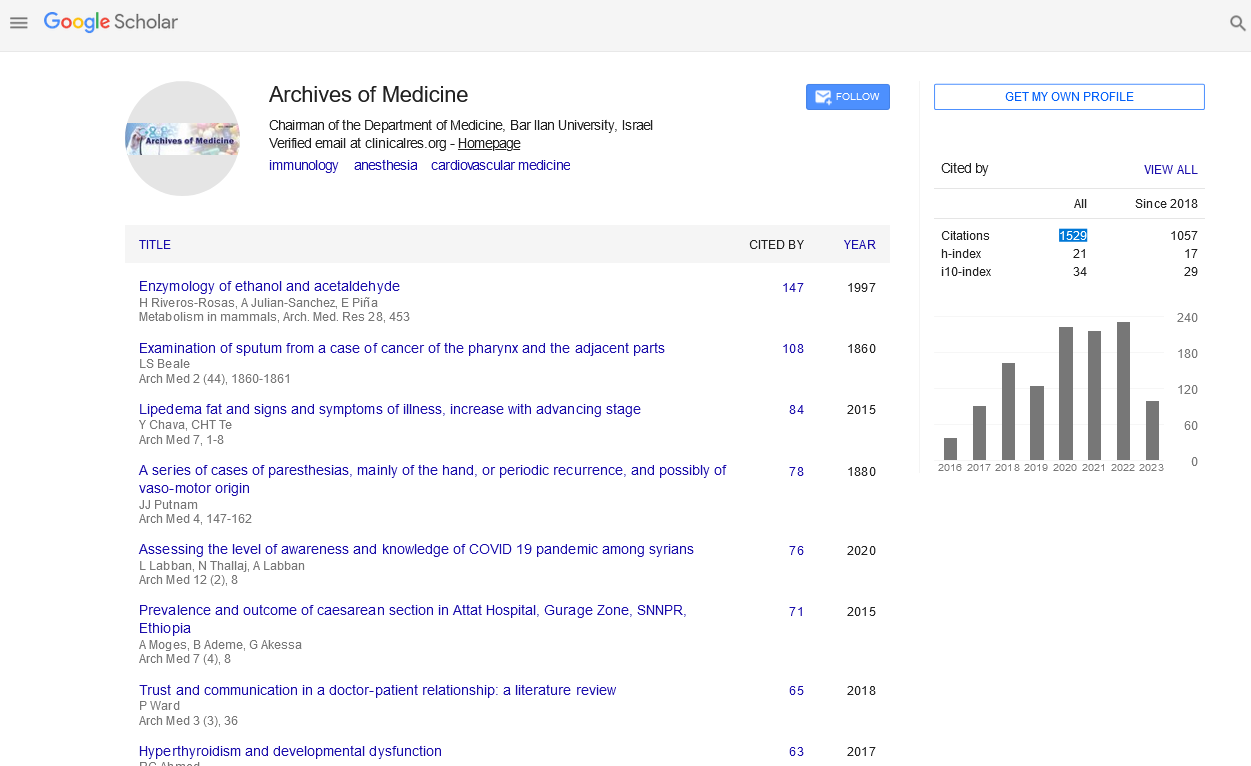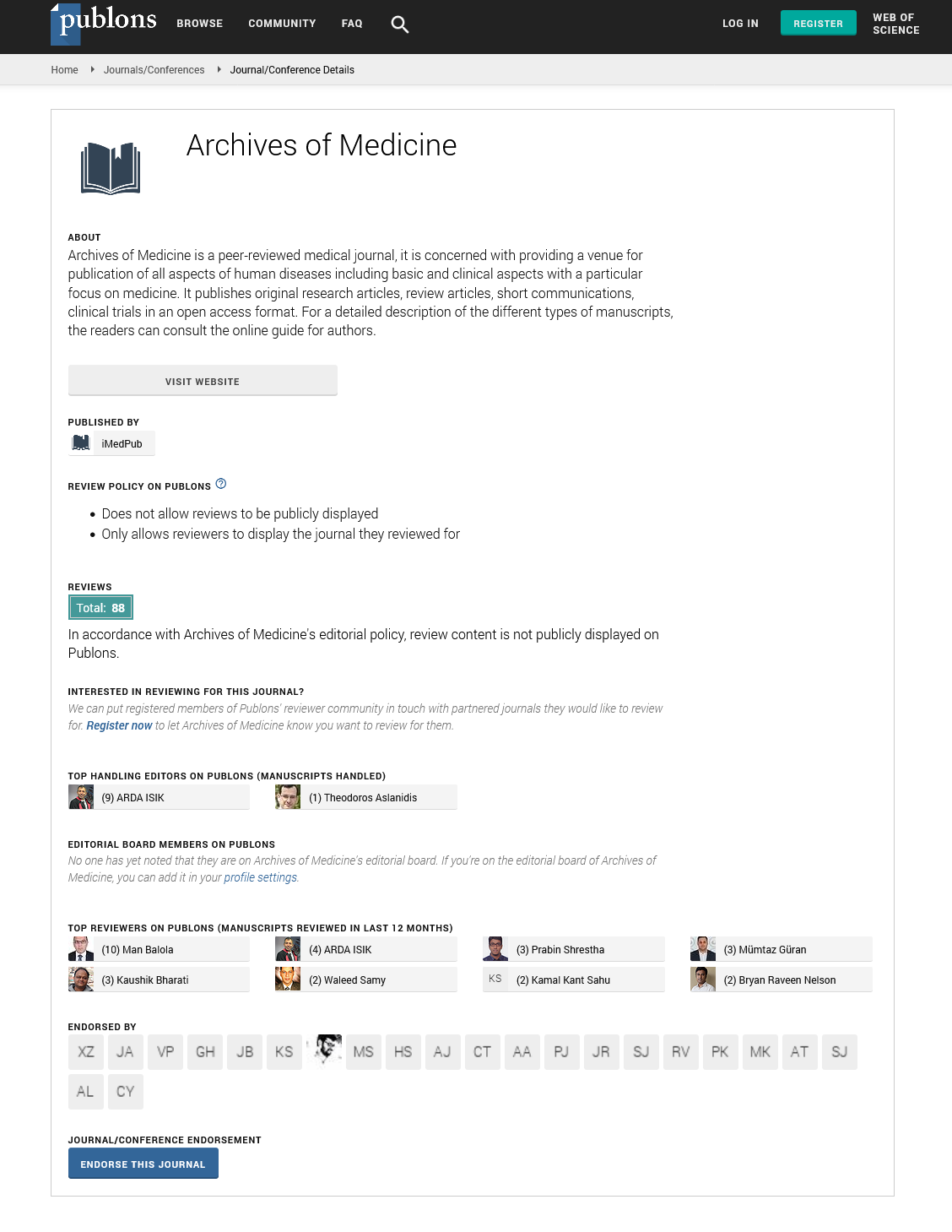Mini Review - (2024) Volume 16, Issue 1
Centralized Wellness: A Glimpse into General Internal Medicine Clinics
Elizabeth Eleanor*
Department of Internal Medicine, Osaka Dental University, 8-1 Kuzuhahanazonocho, Hirakata 573-1121, Osaka, Japan
*Correspondence:
Elizabeth Eleanor, Department of Internal Medicine, Osaka Dental University, 8-1 Kuzuhahanazonocho, Hirakata 573-1121, Osaka,
Japan,
Email:
Received: 01-Jan-2024, Manuscript No. ipaom-24-14812;
Editor assigned: 03-Jan-2024, Pre QC No. P-14812;
Reviewed: 17-Jan-2024, QC No. Q-14812;
Revised: 20-Jan-2024, Manuscript No. R-14812;
Published:
27-Jan-2024
Abstract
A Glimpse into General Internal Medicine Clinics" provides an insightful overview of the pivotal role internal medicine clinics play in promoting holistic health. Focusing on the concept of centralized wellness, this abstract explores how these clinics serve as comprehensive hubs for preventive care, chronic disease management and patient education. Through an interdisciplinary approach, they address physical, mental and emotional well-being, fostering a proactive healthcare model that empowers individuals to lead healthier lives.
Keywords
Healthier lives; General internal medicine; Treating
illnesses; Diseases; Healthcare
Abstract
A Glimpse into General Internal Medicine Clinics" provides an insightful
overview of the pivotal role internal medicine clinics play in promoting
holistic health. Focusing on the concept of centralized wellness, this
abstract explores how these clinics serve as comprehensive hubs for
preventive care, chronic disease management and patient education.
Through an interdisciplinary approach, they address physical, mental
and emotional well-being, fostering a proactive healthcare model that
empowers individuals to lead healthier lives.
Introduction
In a world where healthcare is often synonymous with
treating illnesses and diseases, the concept of wellness
tends to take a backseat. However, the tide is turning as
healthcare providers increasingly recognize the importance
of proactive wellness measures in preventing chronic
conditions and promoting overall health. Within this shift,
general internal medicine clinics are emerging as pivotal
players in fostering centralized wellness approaches [1].
Literature Review
General internal medicine clinics have long been
regarded as the cornerstone of primary care, specializing in
the diagnosis, treatment and management of adult patients
across a spectrum of health concerns. Traditionally, these
clinics primarily focused on addressing acute and chronic
medical conditions, offering reactive care in response to
patient complaints or symptoms.
However, the evolving landscape of healthcare, marked
by escalating rates of chronic diseases and a growing
emphasis on preventive care, has prompted a fundamental
shift in the role of general internal medicine clinics. Today,
these clinics are transforming into hubs of comprehensive
wellness initiatives, aiming to empower patients to take
charge of their health proactively [2,3].
The pillars of centralized wellness
Centralized wellness within general internal medicine
clinics is built upon several foundational pillars:
Preventive screenings and assessments: Rather than
waiting for symptoms to manifest, these clinics prioritize
regular preventive screenings and health assessments to
identify potential risk factors and intervene early. From
blood pressure checks to cholesterol screenings and cancer
screenings, these assessments serve as proactive measures to
detect and mitigate health issues before they escalate.
Lifestyle modification programs: Recognizing the
profound impact of lifestyle choices on overall health,
general internal medicine clinics offer tailored programs
focused on nutrition, exercise, stress management and
smoking cessation. By equipping patients with the
knowledge and tools to make healthier choices, these
programs aim to prevent the onset of chronic conditions
and improve overall well-being.
Chronic disease management: For patients already living with chronic conditions such as diabetes,
hypertension, or cardiovascular disease, these clinics provide
comprehensive management plans aimed at optimizing
health outcomes and minimizing complications. Through
regular monitoring, medication management and lifestyle
interventions, patients receive personalized support to
better manage their conditions and lead fulfilling lives.
Mental health support: Mental health is increasingly
recognized as integral to overall wellness. General internal
medicine clinics incorporate mental health screenings and
provide access to counseling services or referrals to mental
health specialists when needed. By addressing mental
health concerns alongside physical health, these clinics
adopt a holistic approach to wellness.
Health Education and Empowerment: Education is
a cornerstone of centralized wellness, with clinics offering
resources, workshops and one-on-one consultations to
empower patients with the knowledge and skills needed to
make informed decisions about their health. By fostering
a culture of empowerment, patients become active
participants in their wellness journey, rather than passive
recipients of care [4-6].
Discussion
Technology plays a crucial role in facilitating centralized
wellness within general internal medicine clinics. Electronic
health records (EHRs) enable seamless communication
and coordination among healthcare providers, ensuring
continuity of care and personalized treatment plans.
Telemedicine platforms expand access to care, allowing
patients to connect with their healthcare team remotely for
consultations, follow-ups and monitoring.
Moreover, wearable devices and mobile health apps
empower patients to track their health metrics, monitor their
progress and engage in self-care activities independently.
From fitness trackers to medication reminder apps, these
digital tools complement traditional healthcare services,
promoting patient engagement and adherence to wellness
goals.
Challenges and opportunities
While the transition towards centralized wellness
represents a positive step forward in healthcare delivery,
it is not without its challenges. Limited reimbursement
models, time constraints and resource constraints may
pose barriers to the implementation of comprehensive
wellness programs within general internal medicine clinics.
Moreover, addressing social determinants of health, such as
access to healthy food and safe housing, requires a multifaceted
approach involving collaboration with community
resources and social services.
However, amidst these challenges lie opportunities for
innovation and collaboration. By leveraging technology,
adopting value-based care models and forging partnerships with community organizations, general internal medicine
clinics can expand their reach and impact in promoting
wellness across diverse populations.
Conclusion
Centralized wellness represents a paradigm shift in
the role of general internal medicine clinics, transcending
the traditional focus on disease management to embrace a
holistic approach to health and well-being. By prioritizing
preventive care, lifestyle interventions, chronic disease
management, mental health support and patient education,
these clinics empower individuals to live healthier, more
fulfilling lives.
As healthcare continues to evolve, the integration of
centralized wellness principles within general internal
medicine clinics holds the promise of not only improving
individual health outcomes but also reducing healthcare
costs and burden on the system as a whole. Through
collaborative efforts and a steadfast commitment to patientcentered
care, these clinics are poised to shape the future
of healthcare by prioritizing wellness as a cornerstone of
healing and thriving.
Acknowledgement
None.
Conflict of Interest
None.
References
- Killian MO, Payrovnaziri SN, Gupta D, et al. Machine learning–based prediction of health outcomes in pediatric organ transplantation recipients. JAMIA Open. 2021;4(1):ooab008.
Google Scholar, Crossref, Indexed at
- Almadhi M, Alsayyad AS, Conroy R, et al. Epidemiological assessment of SARS-CoV-2 reinfection. Int J Infect Dis. 2022 Oct 1;123:9-16.
Google Scholar, Crossref, Indexed at
- Nordström P, Ballin M, Nordström A, et al. Risk of SARS-CoV-2 reinfection and COVID-19 hospitalisation in individuals with natural and hybrid immunity: a retrospective, total population cohort study in Sweden. Lancet. 2022;22(6):781-90.
Google Scholar, Crossref, Indexed at
- Wahyuddin W, Vongsirinavarat M, Mekhora K, et al. Immediate effects of muscle energy technique and stabilization exercise in patients with chronic low back pain with suspected facet joint origin: A pilot study. Hong Kong Physiother J. 2020;40(02):109-19.
Google Scholar, Crossref, Indexed at
- Patel VD, Eapen C, Ceepee Z, et al. Effect of muscle energy technique with and without strain–counterstrain technique in acute low back pain—A randomized clinical trial. Hong Kong Physiother J. 2018;38(01):41-51.
Google Scholar, Crossref, Indexed at
- Verma M, Tapper EB, Singal AG, et al. Nonhospice palliative care within the treatment of end‐stage liver disease. Hepatol. 2020;71(6):2149-59.
Google Scholar, Crossref, Indexed at






